Danielle Hopson Begun admires a crop of ulva, or sea lettuce, that grew naturally on the sugar kelp lines. The Shinnecock farmers will dry the sea lettuce along with the kelp to eventually package and sell as a soil fertilizer at the local farmers market. (photo by Jenna Kunze)
REPLENISHING WHAT HAS BEEN STOLEN
Indigenous Kelp Farmers are Regenerating Long Island’s Polluted Bays
by Jenna Kunze
MORICHES BAY, New York—On the wave-lapped shores of eastern Long Island, three women walk into Moriches Bay wearing clunky waders and long green rubber gloves that billow out at the biceps, giving the effect of a certain green superhero. One has a bandana tied around her head, and another carries a knife. They all drag empty onion bags behind them into the chest-high water.
“We came out here to clean the water,” said Donna Collins-Smith, one of the three Shinnecock Kelp Farmers here today and like the others, a citizen of the Shinnecock Nation. “Somebody has got to come out here to replenish what has been stolen.”
The Shinnecock are the closest federally recognized tribe to New York City, with land on Long Island’s South Fork, about 85 miles to the east. Over the last three decades, overdevelopment on the South Fork, one of the priciest ZIP codes in the United States, has led to an increase in septic-tank waste and fertilizer runoff, degrading the water quality and killing off marine life in the bays nearby the Shinnecock Nation.
The Kelp Farmers—they’re all relatives, of different ages—see it as their responsibility to clean up their polluted homelands. Their tool? Sugar kelp.
After gliding into the bay on June 2—the temperature “a balmy 65 degrees,” farmer Danielle Hopson Begun reads off the pink bopping thermometer tethered to her waders—Collins-Smith, 66, unearths an underwater kelp line about a half mile from shore. After six months of growth, kelp springs from the rope like matted hair, several feet long and dragging in all directions. You can’t tell from looking at it, but with each fistful pulled from the rope and shoved into an onion bag, Collins-Smith and her relatives are removing harmful toxins from the water.
“Look at that,” Collins-Smith says, holding up long strands of kelp. “We did all that we could, and then nature did the rest.” She laughs about how it could be confused for a lasagna sheet before it's boiled. “I wonder if anybody has ever tried that?” she asks.
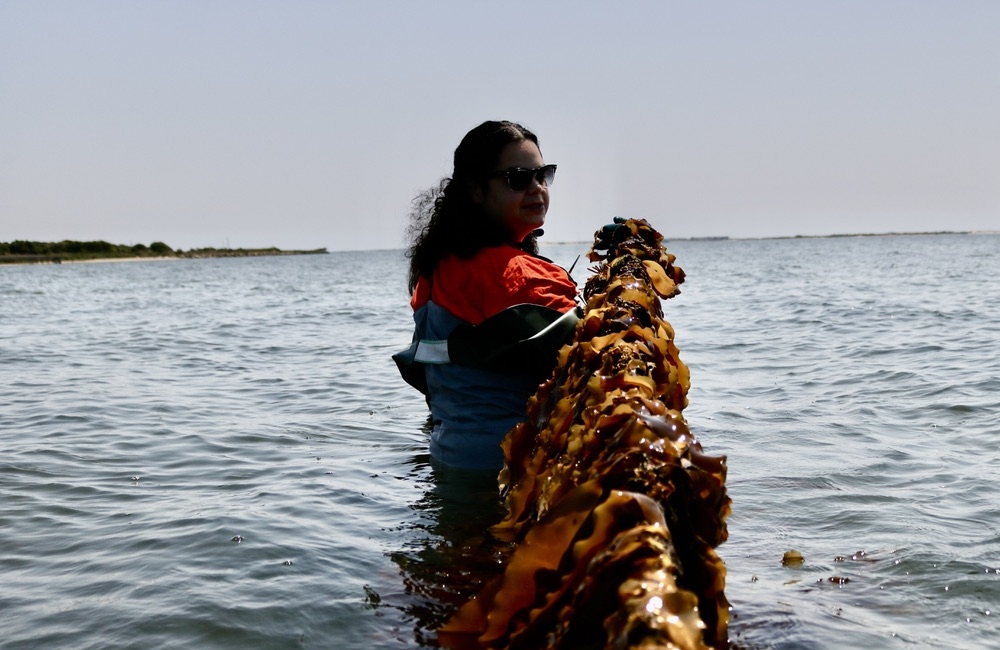
Tela Troge, the Shinnecock Nation's attorney and kelp farmer,believes the women’s traditional and historic connection to their waterways set them apart from other conservationists. “The work that we do is really pure from our hearts, because we’re trying to get back to where our stories told us that we should be, and participants in this ecosystem," she said. (photo by Jenna Kunze)

Collins-Smith examines the sea lettuce "Green is health," she says. (photo by Jenna Kunze)
WHAT'S AT STAKE
Before the waters surrounding southeastern Long Island were the backyards of the ultra-rich, they had been home to the Shinnecock people and other tribal nations for 10,000 years.
The Shinnecock people have traditionally subsisted off the land and sea. Seaweed, a major crop since time immemorial, was cultivated for widely different uses, including steaming clams, insulating homes, fertilizing gardens, and its medicinal powers.
But when English settlers arrived on the South Fork in the 1640s, they gradually diminished the sovereign rights and land base of the Shinnecock. The tribe gave the newcomers a swath of land to live on, but the settlers wanted more, and eventually stole all but 3,600 acres of land from their neighbors.
Since 1859, the Shinnecock Nation territory has been reduced by nearly 80 percent, and been moved to lower land on a peninsula on the island’s south shore. That land reduction coincided with diminished access to their waters, making it harder to harvest kelp.
In 2019, when several Shinnecock citizens were approached by GreenWave—a nonprofit that funds regenerative ocean farms—about technical assistance in starting a kelp farm, Tela Troge, the tribe’s attorney and one of the Kelp Farmers, thought it was a natural fit.
At the core of Troge’s work is defending Shinnecock tribal sovereignty, which is still being undermined by state and federal agencies. Over the last decade, she and several other Kelp Farmers were involved in pushing for legislation to protect unmarked graves (In May, Gov. Kathy Hochul signed a law to create a process for when an unmarked grave is unearthed on private property during development.) In 2018, the tribe sued the state Department of Environmental Conservation (DEC) after it gave several Shinnecock fishermen tickets for exceeding catch and size limitations. The lawsuit argued that they had been exercising their treaty-protected fishing rights. A federal judge dismissed it in 2021, saying there was insufficient evidence of discriminatory practices by state and local law enforcement, but last August, a federal appeals court allowed the suit to continue.
The Shinnecock Kelp Farmers are one of nine pilot farms—the others are in Rhode Island, Alaska, and Connecticut—being assisted by GreenWave’s Kelp Climate Fund. The fund gives each farm technical support to begin operations and pays $1 for every foot of kelp seed planted. The Kelp Farmers are also receiving funding from the La Mer Blue Heart Oceans Fund, the Joyce and Irving Goldman Family Foundation, the Nature Conservancy, and Suffolk County’s Water Quality Protection and Restoration Program.
“Shinnecock Kelp Farmers is a really cool way to assert our sovereignty in a way that's so beneficial to our waterways, to our communities, and even like the air that we breathe,” Troge said. “Even though we have those reserved rights, it's still challenged to this day by the DEC.”
The Shinnecock’s right to harvest kelp was first reserved in 1659 when the tribe sold a tract of its land to a settler with the caveat that the tribe “shall keep [its] privilege of fishing, fowling, hunting, or gathering of berries or any other thing for our use.”
According to Troge, that right was challenged in a series of lawsuits against the tribe throughout the 1800s, but the state court ultimately held that the Shinnecock never relinquished their rights to manage their resources, including leasing seaweed lots in Shinnecock Bay.
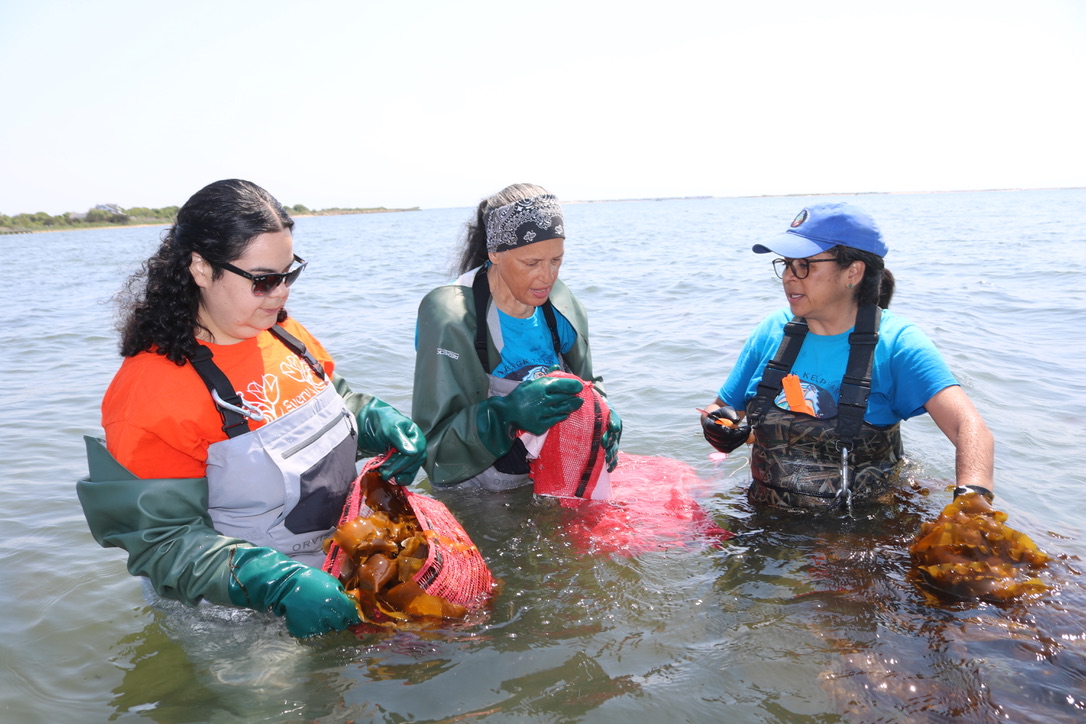
Harvesting is a practice of patience and teamwork, and the Shinnecock Kelp Farmers laugh and joke their way through the job. "We have really good bonds and shared culture, and are working for the same reasons," said Troge (left), "But were also working as women for our survival. (photo by Jenna Kunze)
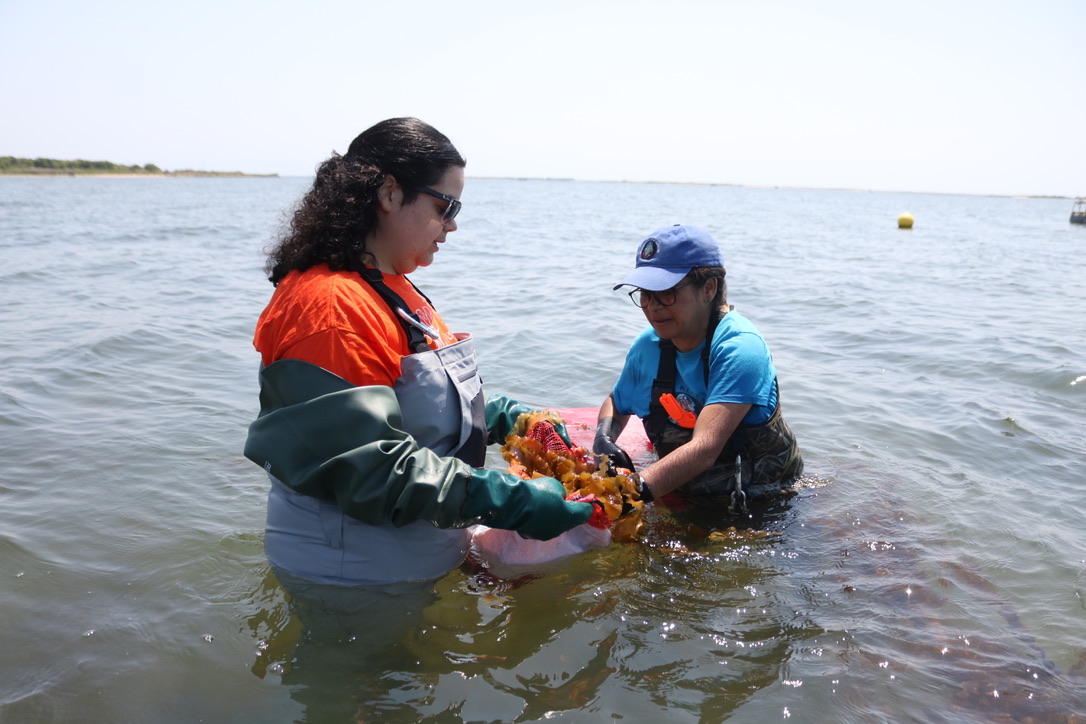
Tela Troge (left) and Danielle Hopson Begun (right) tag team filling a bag full of sugar kelp. (photo by Jenna Kunze)
THEN AND NOW
Looking inland at the shore in Moriches Bay, Troge, 35, remembers a time when the waters surrounding her homeland were teeming with life.
In the summers, she and her cousins would clamber barefoot into the creek behind their grandmother’s house that fed into Shinnecock Bay, their feet inevitably cut up by razor crabs. Imagining themselves backyard marine biologists, they would peer into the clear stream and identify oysters, clams, horseshoe crabs, and all kinds of marine life—all visibly thriving.
“Things changed in elementary and middle school, when we got hit by a series of really bad brown tides and red tides–bad algae blooms caused by an imbalance of nitrates in the water, which come from the septic and lawn fertilizers seeping into the water,” Troge said. “Now, you see a dead bluefish, maybe.”
Through the 1970s, Long Island, especially Shinnecock Bay, boasted the most abundant hard-clam fishery in the United States. Those clams were filtering about 40% of the water per day by absorbing excessive nitrogen that breeds harmful algae, said Christopher Gobler, chair of Stony Brook University’s coastal-ecology department. Nitrogen leaches into the groundwater through fertilizers and septic-waste runoff from the roughly 380,000 housing units in Suffolk County that have cesspools or septic tanks. In the bays, excess nitrogen causes algae to grow faster than ecosystems can handle, robbing fish and other aquatic life of the oxygen they need to survive.
The Shinnecock Bay clam fishery has declined by 99% since its peak in the 1970s due to overharvesting, said Gobler, who has spent the last several decades researching coastal ecology in the Long Island bays. It reminds him of a scene from the Disney movie Finding Nemo.
“If you remember that movie, Nemo, when he’s stuck in the fish tank, sticks a little rock in the filter and the water turns green,” Gobler explains. “The clams were like the filter for the bay, and so without them, the water in our case turned brown.”
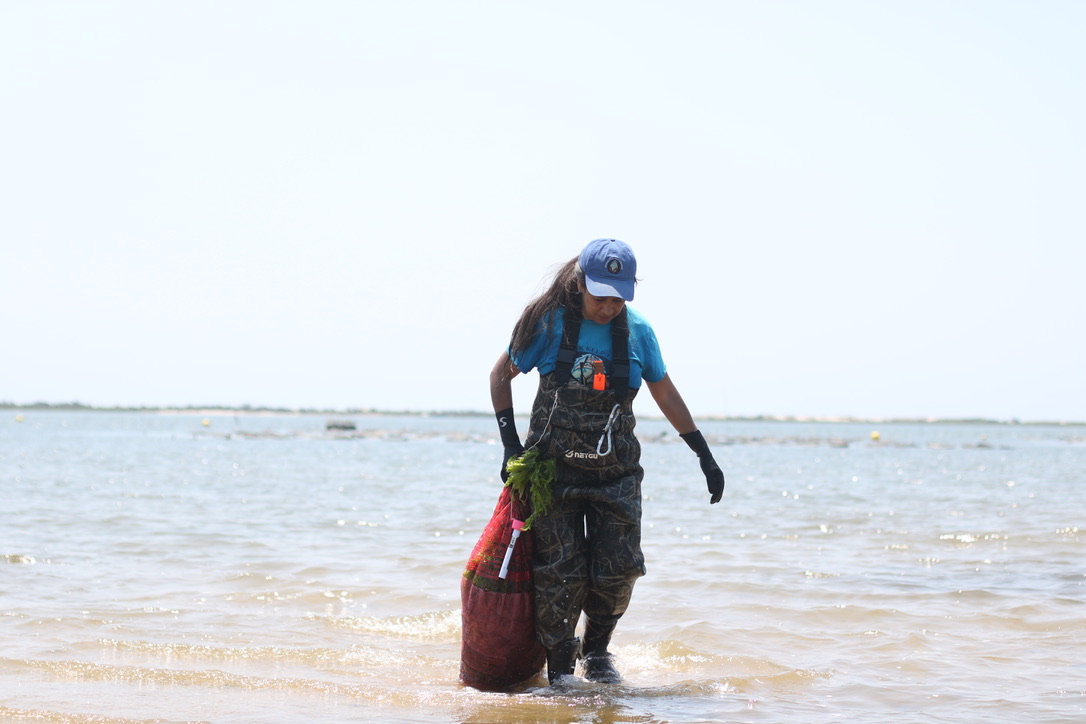
The women walk nearly a mile on the beach with their harvest to transport the kelp to their cars, to eventually dry at home. In total, they harvested ten bags of kelp, and went back out in the following weeks to collect the remainder. (photo by Jenna Kunze)
‘THE KELP CAN HELP’
But the kelp can help clean the water quality and restore the bays, Gobler said.
Climate activists and farmers around the world are turning to kelp to sequester carbon in the ocean and help marine life survive ocean acidification. One study from 2016 estimates that seaweed removes around 200 million tons of carbon dioxide from the atmosphere every year– about as much as the annual emissions from the state of New York.
For three seasons now, the Shinnecock Kelp Farmers have been compiling their own statistics of how much carbon and nitrogen was sequestered by the kelp they planted.
Each August, the women build a pop-up laboratory, where they grow kelp around PVC pipelines in aquarium tanks, using source tissue they dove for. The farmers—who all work full-time day jobs—tend to the growing kelp for six to eight weeks in a highly controlled environment. To stimulate growth and vitality, they read the seeds Joy Harjo poems and sing to them in their Algonquin language.
“We’re really preparing our seedlings for the very important job they have for the bay,” Troge said. In the winter, the women plant the kelp onto lines anchored underwater, where it grows for about four months until harvest.
When the Shinnecock Kelp Farmers began in 2020, they harvested about 800 feet of kelp in just one location. Since then, as of the final week of June, they’ve harvested 7,000 feet of kelp in three locations between Shinnecock Bay and Moriches Bay.
This year, for the second time, the women are drying, packaging, and selling their yield at a local farmer’s market as a soil addendum to grow gardens “the Native way.”
In exchange for the technical assistance, GreenWave asks each farm to collect data, though the farm retains ownership of that data. Once a month, the farmers involved in the Kelp Climate Fund—now up to 40—take photos and simple measurements of their kelp in three locations on their farm in order to track growth rates and local ecosystem health.
“From there, we're able to extrapolate ecosystem benefits: So nitrogen, carbon, and reef restoration at the farm level,” Bren Smith, GreenWave’s co-founder, told Native News Online. “But then also nationally, we're able to do it in order to show impact.”
This season, the Kelp Climate Fund has helped local farmers remove a total of more than 68,000 pounds of carbon and more than 5,000 pounds of nitrogen from bays and oceans, according to its count as of June.
The Shinnecock Kelp Farmers this year alone removed 2,000 pounds of kelp, containing 56 pounds of carbon and 4 pounds of nitrogen.
Gobler called the Shinnecocks’ results “a great achievement.”
“We’re not going to reverse climate change with kelp farming,” he added. “But there’s this thing called the halo effect, where with each kelp deployment, you can improve the water quality to the benefit of the localized regional waters.”
“We’ve been seeing results almost immediately,” Troge said. “Everything from shorebirds to sharks really flock to our farm.” You can also see snails on their kelp lines, she adds.
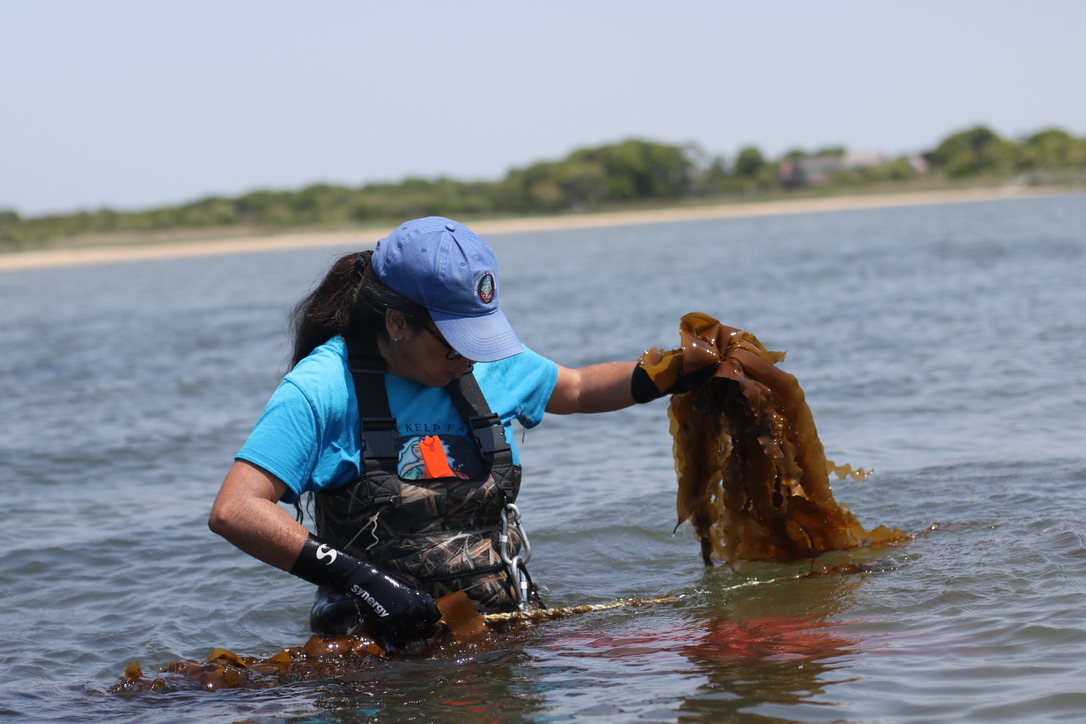
"Knowing about climate change and how devastating the effects are for all of us is a paralyzing event," said Danielle Hopson Begun as she cuts kelp from the line. "One way to combat that is to take action—this happens to be one way we can." (photo by Jenna Kunze)

Each time they fill an onion bag full of kelp, the women drag it a half mile into shore. (photo by Jenna Kunze)
MOTHERS TO MANY
It’s not just the health of the waters the Shinnecock kelp farmers are concerned with: They’re working to rebuild the health of their community and the surrounding community of Suffolk County for the next seven generations.
As Troge works with her cousin Danielle Hopson Begun, 53—one holding open a bag, the other methodically cutting kelp from the line—their conversation inevitably turns to their children. Troge has a toddler at home who woke up early that morning; Hopson Begun has a college-aged daughter who spent the night before at a Taylor Swift concert.
The women work with the health of their children in mind, but also the help of the larger communities. They hope to expand their farm, continue selling their kelp as a product, and eventually create green jobs helping with the farm for Shinnecock community members. The roughly 700 citizens who live on the reservation have a median household income of about $30,000, less than a third of the median income of Suffolk County residents, Troge says. And those are mostly multigenerational homes, so that income has to support many people.
Creating green jobs will benefit not only the Shinnecock citizens who will fill them, but also the local fishermen whose livelihood depends on healthy waters, and the residents who eat those fish.
“We’re the water protectors. That’s our main goal,” Hopson Begun says as she runs her knife across rope, offering me a piece of freed kelp to snack on. She doesn’t see a distinction between her role as a nurturer of her children, to other people’s children (she’s a full-time youth social worker), to their environment; It’s all connected.
“I am going to be a good ancestor,” she says. “Seven generations from now, people will look back and say, ‘Oh, this is what this group of women were doing.’ They’ll be able to say: they thought about us, they used all of their Indigenous knowledge as well as the most current science, and they did everything that they could. And I’m going to do the same.”
